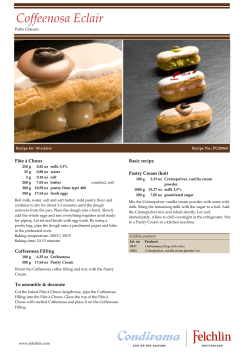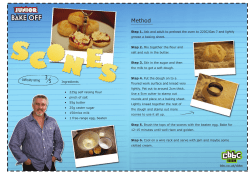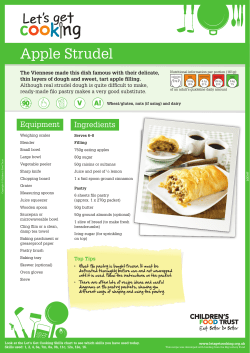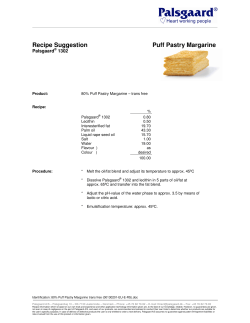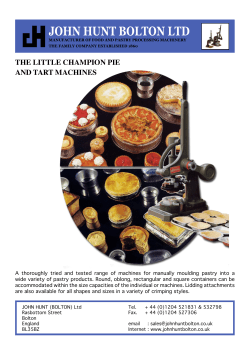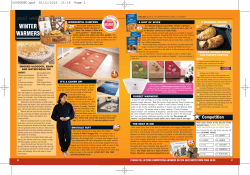
angela day
SW_VER_E1_280408_p10 C M Y K 10 angela day MONDAY APRIL 28 2008 The Star verve feedback E-mail verve@inl.co.za SMS 32546 (Each SMS costs R1) COURGETTE AND FETA TART BROCCOLI AND CHICKEN QUICHE Serves 4 1 x 25cm pastry crust, baked blind 1 onion, finely chopped 2ml curry powder 200g cooked chicken, finely chopped 200g broccoli, cooked and chopped 5 extra large eggs 150ml milk 300ml cream 15ml mayonnaise salt and pepper to taste 125ml grated cheddar cheese Heat oil in a saucepan and lightly fry onion and curry powder for one minute. Cool. Spoon onion mixture onto pastry base. Top with the chicken and broccoli. Combine eggs, milk, cream and mayonnaise, season to taste and pour over chicken and broccoli. Sprinkle over grated cheese and bake at 180°C for 30 to 40 minutes. Serves 4-6 23cm square pastry crust, baked blind 4-6 courgettes,depending on size, thinly sliced 15ml olive oil Salt and freshly ground black pepper juice of one lemon 5ml finely grated lemon rind 1 egg 100ml cream 150g feta cheese, crumbled extra olive oil balsamic vinegar handful mint leaves Make pastry and roll it to fit a fluted 25cm square loosebottomed quiche pan. Prick well with a fork and bake blind. Place courgettes in a bowl and add salt and pepper, oil, lemon juice and rind. Toss well to coat. Layer courgettes neatly on the pastry. Lightly beat the egg and cream and pour over courgettes. Bake at 180°C for 20-25 minutes. Top with feta cheese and mint leaves. Serve drizzled with extra olive oil and balsamic vinegar. Serve warm or at room temperature. RECIPE PICTURES: JENNIFER BRUCE MAIN PICTURE: AUSTRALIAN WOMEN’S WEEKLY Use shortcrust pastry to make these delectable dishes BERRY TARTS 8 x 8cm individual pastry cases, baked blind Pastry cream: 300ml milk 125ml castor sugar 4 egg yolks 30ml flour 30ml cornflour 60ml lemon juice grated rind of one lemon 500g mixed fresh berries (raspberries, strawberries) 125ml apricot jam, warmed To make pastry cream, place milk in a saucepan and bring to the boil. Beat sugar and yolks in a bowl with an electric beater until thick and creamy. Add flour and cornflour, and mix well. Pour hot milk onto egg yolk mixture, mixing well. Beat in lemon juice and rind. Return to heat and bring to boil. Reduce heat and simmer one minute. Remove from heat, cover with baking paper and leave to cool. (Covering with paper helps prevent a skin forming.) Spoon pastry cream into pastry cases and top with fresh berries. Brush with warmed apricot jam to give a shiny glaze. Pastry making can be quite a challenge and many cooks reach immediately for the frozen, ready-made kind. In the third of her baking tutorials, Angela Day tells you how to make the perfect shortcrust pastry at home. By following this step-by-step guide, you will be well on your way to producing melt-in-the-mouth tarts and pies. HOW TO MAKE SHORTCRUST THE PASTRY JOY OF BAKING PART 3 BAKING BLIND Baking blind simply means pre-baking the pastry of a pie or tart before spooning in the filling. Baking a pastry shell beforehand ensures a crisp, evenly-cooked crust which won’t be soggy and undercooked once the filling is in. Dry beans are usually placed on top of the dough so it stays flat during cooking. It’s an easy step that can result in pastry perfection. here are many different kinds of pastry, and you have no doubt enjoyed baked dishes made with phyllo, puff and choux pastry. Shortcrust pastry is the kind most often used as a base of a tart or pie. A leavening agent isn’t used and so it doesn’t puff up during baking. The “short” in the name refers to T “shortening”, a fat in semi-solid form such as butter, margarine or lard. Essentially, shortcrust pastry is made by rubbing chilled fat into flour to create a loose, crumbly mixture that is then bound using a little cold water. To ensure the pastry is well-cooked and light, most recipes call for blind baking it before adding the filling. STEP 1: STEP 3: Roll the pastry out to 5mm thick on a lightly floured work surface. Using the rolling pin as a support, lay the rolled pastry over the top of the tart pan. Cover the raw pastry shell with non-stick baking paper and fill with dried beans. This ensures the pastry retains its shape while being cooked. STEP-BY-STEP PICTURES: ESSENTIAL BOOK OF BAKING STEP 2: STEP 4: Gently press the pastry into place so that it fits snugly into the tin. Trim to fit and prick base and sides with a fork. Chill 30 minutes in fridge before baking. Place tin on a baking tray and bake at 180°C for 10 minutes. Remove from oven and set aside the paper and beans. Return the crust to the oven for a further 5-10 minutes. Store in airtight container or freeze. The pastry case can be frozen at this stage if desired. SMARTEN UP YOUR MUFFINS WITH RAMA IDEA Are you faced with the challenge of what to put in lunchboxes? Try this healthy muffin, spread with Rama Idea and top with cheese or jam. Combine dry ingredients in a large bowl and mix well. Stir in cake fruit mix and dates. Check the date of the flour. Stale flour does not make the best pastry. Ensure that the ingredients are measured exactly before you begin. Work quickly and handle the dough as lightly as possible. Overworking the dough promotes the formation of gluten strands, which results in a hard, chewy texture, such as you get with bread or pizza dough. Shortcrust pastry needs to be light. Gluten is less likely to develop if you ensure the flour granules are well coated with the butter – they should look like coarse breadcrumbs – before adding the liquid. When rolling out the pastry, roll in one direction only. Turn the pastry, not your rolling pin. Turn the pastry 45 degrees and roll again in the same direction, continuing until the desired size is reached. Too much water also promotes gluten development. It will make the pastry sticky and difficult to roll and, when baked, will shrink more and be hard. SHORTCRUST PASTRY BY HAND This quantity of pastry is enough to make 2 x 20cm pastry cases. If you intend to make only one tart, quiche or pie, divide the pastry in half and freeze the other half for later. 500ml flour pinch salt 150g butter, chilled and cubed 60-80ml iced water 15ml lemon juice Sift the flour and salt into a bowl and add the butter. Rub the butter into the flour using your fingertips only, lifting the mixture as you go to incorporate air. Combine the water and lemon juice, and gradually add to the dry ingredients. (The lemon juice encourages the gluten to relax.) With a knife, start bringing the dough together by cutting and turning to make it begin to cling together. Once this happens, discard the knife and bring the dough together with your fingertips. Add a little more water if needed. All the bits of flour and fat should be incorporated. Knead lightly. Wrap in clingfilm and place in fridge for 30 minutes. Use as required. USING A FOOD PROCESSOR Place the flour into the bowl of a food processor and add butter and a pinch of salt. Process until mixture resembles coarse breadcrumbs. Add 50ml-80ml chilled water and process until the mixture begins to come together. Gather up the dough and knead lightly on a lightly floured surface until smooth SHORTCRUST PASTRY VARIATIONS Wholesome Bran Muffins Makes about 30 250ml wholewheat flour 375ml cake flour 500ml bran 5ml salt 10ml bicarb 250ml mixed cake fruit 250ml chopped dates 500ml milk 125ml oil 375ml soft brown sugar 2 large eggs WHAT YOU NEED TO KNOW Mix together milk, oil, sugar and eggs. Pour into dry ingredients and mix well. Spoon into an airtight container and keep in refrigerator for an hour or overnight (this mixture will keep for up to three weeks). Spoon into well-greased muffin pans and bake at 180°C for 20 to 25 minutes. Serve spread with Rama Idea and your favourite jam, or even top with cheese. SWEET SHORTCRUST PASTRY: Add 80ml castor sugar after rubbing in the butter. COCONUT: Add 60ml desiccated coconut after rubbing in the butter. You may also need a little extra cold water to mix. CITRUS: Add finely grated lemon or orange rind to the flour. NUTTY: Add 60ml toasted ground almonds or hazelnuts after rubbing in the butter. BE PREPARED Keep a supply of ready-made pastry in the freezer ready to be used. Roll pastry out between two sheets of lightly floured baking paper, roll up and pop into the freezer. Pastry can freeze for 3 months. Make sure the pastry is completely thawed before using. If using frozen raw pastry shells, they can be baked from frozen.
© Copyright 2025

